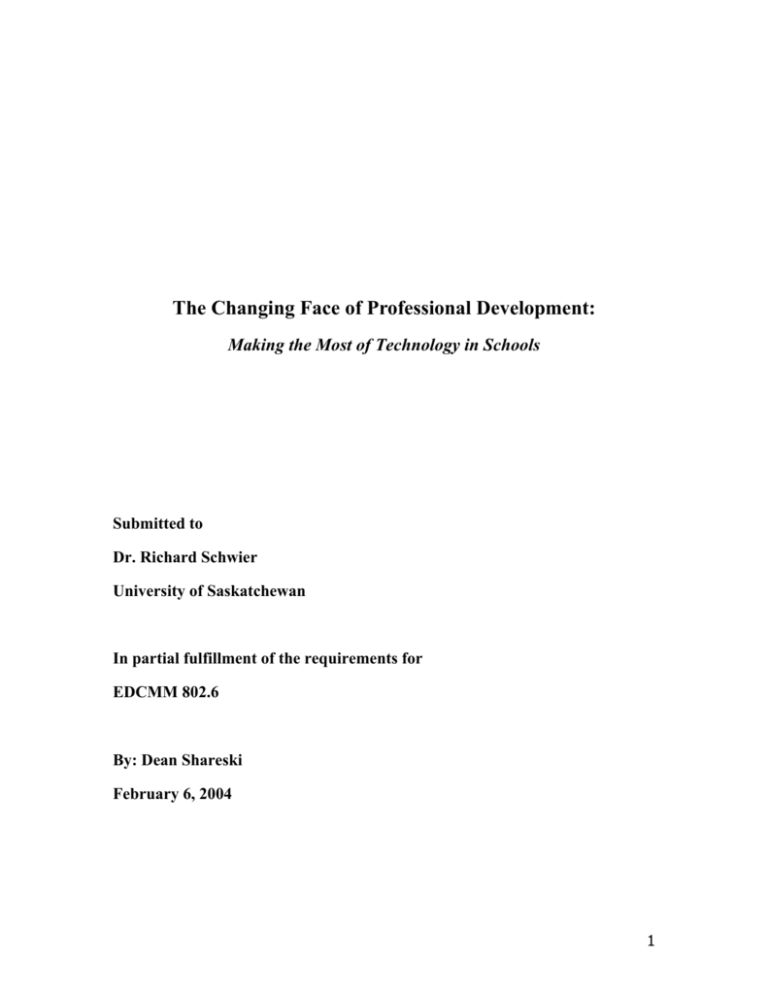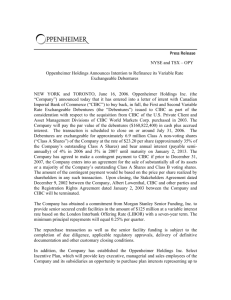a copy of the entire paper
advertisement

The Changing Face of Professional Development: Making the Most of Technology in Schools Submitted to Dr. Richard Schwier University of Saskatchewan In partial fulfillment of the requirements for EDCMM 802.6 By: Dean Shareski February 6, 2004 1 Introduction “Screensaver disease”, “Toolishness” and “Power Pointlessness” are all terms used by education critics to describe a disturbing phenomenon infiltrating schools. Loads of technology but not necessarily loads of learning. Technology has made a huge impact on spending and infrastructure but has it led to greater student achievement? Oppenheimer (1997) claims that computers and technology have been a waste of money and have only added to North America’s failing education system. Cuban (2001), a professor at Stanford University writes,”Two decades after the introduction of personal computers in the nation, with almost all schools wired for the Internet and nearly $8 billion spend annually on school technologies, the results get a failing grade.” All of these viewpoints invite us to ask some hard questions. If it is true that technology is largely being wasted, and in fact creating more problems than it is solving, we need to find out why. Once we determine why, we can then proceed to make the necessary changes to create a more meaningful learning experience for students. Few would argue that simply placing technology in classrooms will in and of itself help students learn and yet the directions taken by many school districts would suggest this is the case. The pressure to integrate technology has left schools with some of the tools but not the understanding regarding how to use them. If one has no mechanical skills, outfitting a garage with all the latest automotive tools would have no impact on one’s ability to work on a car. Many teachers are experience similar situations. A lack of professional development funds, as well as poorly designed professional 2 development programs has made it easy for cynics to say that technology does not make a difference in student learning. In the rush to equip schools with technology, professional development has often taken a backseat in many cases. Many school districts that did not neglect professional development are currently reaping the rewards initially promised by the early technology enthusiasts. Yet, some of those districts which did include a reasonable portion of funding to professional development have not seen the changes they hoped. In some cases, school districts have de-emphasized technology to the point where it’s rarely used in daily practice. Any change or implementation to our education system must address the issue of student achievement (Lambert, 1998). How do we measure the role of technology in student achievement? That is indeed the bottom line question. Research indicates that this may not be a question that can be easily proved with even a myriad of data (Kirkpatrick & Cuban 1998). Guskey (2002) believes it is best to look for evidence and not necessarily proof that is collected using a variety of methods. Stakeholders are looking for evidence that their investments are paying off (Guskey & Sparks 1996) (Haycock & Jopson 1999). Professional development is a key ingredient by which change and success will occur (Rodriguez, 2000). Why have many of our current practices failed? What changes need to be made? What does a quality professional development program look like? Answer these questions to reveal the prescription that impacts student achievement. 3 Defending the Faith As educational technologists, we cannot ignore the hard questions that challenge our existence. As with any movement or philosophy, we must be willing to enter into debate that defends and understands more clearly why we do what we do. Oppenheimer, in his article “The Computer Delusion” (1997), challenges five ideas brought forth by those supporting technology in education. 1. 2. 3. 4. 5. Computers improve both teaching practices and student achievement. Computer literacy should be taught as early as possible; otherwise students will be left behind. To make tomorrow's work force competitive in an increasingly high-tech world, learning computer skills must be a priority. Technology programs leverage support from the business community -- badly needed today because schools are increasingly starved for funds. Work with computers -- particularly using the Internet -- brings students valuable connections with teachers, other schools and students, and a wide network of professionals around the globe. These connections spice the school day with a sense of real-world relevance, and broaden the educational community. In many cases, his arguments are valid. I would argue that the potential that exists, could, in all cases, refute his idea that technology should not be pursued as a tool to improve student learning. I agree with Oppenheimer’s (1997) claim computers don’t improve student achievement. First of all, most testing that is done, may not reflect the true impact of computers. As will be argued later, computers provide increased opportunity for collaboration and socialization that are not measured by most tests (Guskey 2002). Oppenheimer (1997) states that collaboration skills may be just as easily developed without the use of computers. I would argue that collaboration with real world problems, without the use of computers, would be limited to local situations and students, thus diminishing the realities of a global society. The Internet provides access to primary 4 sources, experts, other classrooms and up to date information allowing students to participate in learning opportunities not afforded to a classroom void of technology. Oppenheimer’s (1997) second argument, that computer literacy should not be taught in the early stages of development, warrants exploration. His argument stems from the fact that children need extensive exposure to sensory experiences and hands-on manipulation of their world. This point may be valid but to say the computers in no way can support in child development is misleading. Software continues to improve to support this type of learning. Further on Oppenheimer (1997) claims that many classes waste valuable time using inappropriate software applications, time devoted to troubleshooting and supporting students as they develop their computer skills. It appears his argument deals more with extremes which certainly need attention. Appropriate use of technology for a five year old would certainly be different from what is appropriate for a twelve year old. I’m not certain that the goal with young learners is to have them develop technological literacy, but the technology may be used to help them develop in many other areas of childhood development. Oppenheimer (1997) also feels that preparing students for the future does not involve teaching them technology skills. If the primary goal of using technology is to train students to be able to handle the technology of the workplace then we need to reexamine our goals. In his article Oppenheimer cites an MIT professor Joseph Weizenbaum, who claims he can teach new students all the technical skills they will need in a summer. This is probably true. Most software is now so intuitive that once you’ve mastered one program, the skills transfer easily. Oppenheimer (1997) also claims that 5 employers are not looking for graduates with great technical skills, but rather those with great ability to work in teams and problem solve. Many advocates (Guskey 2002; McKenzie 1999; November 2001) of educational technology have been saying the same thing for years. Technology has little use in itself. The classrooms who are experiencing revitalization emphasize groups of students working together to solve problems. Sometimes problem solving activities involve computers, sometimes they don’t. The students are typically so involved with the learning; they don’t even consider the technology and yet they utilize it in various ways to support their work. The technology becomes transparent. As far as the role of business in education, Oppenheimer (1997) warns of business’ potential to adversely affect the integrity of schools and influence curriculum in negative ways. Partnerships with schools is a growing trend which cannot be entirely ignored. If approached with caution and intention, many of these pitfalls can be eliminated. I recently had the opportunity to visit Ococee Middle School in February 2002. This school is a demonstration school for technology in Orlando, Florida. The discussion revealed a very deliberate process for securing business partners. Various companies vie for the contract to outfit the school with technology. Each was involved in extensive interviews regarding their role in the partnership. The principal felt confident that each of these companies had the moral purpose that Michael Fullan (2001) described in his book Leading a Culture of Change. Basically, the moral purpose of these companies combines their desire to serve their community and make a profit. Often seen as contradictory goals, Fullan (2001) has no problem seeing them operate in harmony. 6 Obviously this may not be the case in every situation but if carefully planned and managed, partnerships with corporate partners do not have to have undesirable implications. Oppenheimer’s final argument is that computers do not help to create community and socialization. I would argue the opposite is true. Certainly there may be instances where this occurs, but again, many advocates of educational technology see the computer as building communities both locally and globally (November 2001). The merit of this is that making connections may not necessarily have the positive impact on students that we hope. November (2001) states that “we need to focus much more of our staff development on preparing teachers to help students manage relationships and learn cultural negotiation.” (November, 2001, p.33) This statement raises two important issues. The first is that all of what Oppenheimer (1997) has argued needs to be addressed in the area of professional development. It also insinuates that we have not been doing what we should in the area of professional development. Further as November (2001) states, “The technical training is necessary but trivial compared to the critical thinking skills.” (November, 2001, p.33) A Recipe for Failure First, I would argue that blanketing the entire technology movement in schools as a failure is a case of over generalization. Yet there is no doubt that the investment has failed to generate the returns that were expected. What were/are the expectations and whose expectations were they? In many cases, this question has never been fully 7 examined or stated. The assumption was that if the machines were in the schools, learning will improve. This was clearly a case of putting the cart before the horse. Teachers felt pressure to use technology but didn’t see academic needs or purposes. From this, three types of teachers emerged. First were those who wanted quick and easy methods to use computers. Drill and practice software was used to reinforce basic skills in a variety of subjects. Typing programs were used that required little effort. Rewriting rough drafts into word processors created neat looking documents. Surfing the Internet was also used without much instruction or guidance. Often computer time was given as a reward for completing work. By themselves, these approaches each has some merit and value but if this was all computers were used for, the return on investment would largely be a disappointment. While these approaches seem like a weak use of technology, there were a large number of teachers were so reluctant and sceptical they didn’t even use technology in any form. A third group of teachers were those looking to tap into the new learning that could happen and they embraced technology and are used it to its full capacity. Those teachers have, either on their own or through funded efforts, been able to transform their teaching style to change how students learn and interact with each other. Their successes were characterized by clear goals and expectations that relate to student achievement developed either by the teachers themselves or by the school district. However, this is not the norm as many school districts choose to develop plans that are either nebulous or fixated more on a scope and sequence of technical skills rather than the use of technology to help students learn. Jamie McKenzie (1999) states, “In all too many cases, technology plans are silent when it comes to student learning or they wax eloquent 8 on lofty goals which relate to the millennium, the workplace and society at large – goals which translate poorly into daily classroom routines" (McKenzie, 1999, p. 2). These types of plans do not seem to be relevant for the classroom teacher but seem to satisfy district needs to proclaim their stake as leaders of technology rich schools. When plans of this nature are employed, it is difficult to develop the type of learning environment that truly improves education. The most you can hope for is that computers and technology will be used to make work easier for students and teachers but it won’t drastically improve learning. November (2001) uses the terms automating versus informating. Automating is the idea of “bolting technology on top of current processes and procedures” (November, 2001, p.xix). This is the model adopted by most schools because it is the least painful and requires the least amount of effort. We could keep doing what we were doing and simply attempt to do it faster and better. A Saskatchewan-based research project entitled Beyond the Mouse and the Modem (2003) surveyed over two thousand Saskatchewan teachers about their knowledge and use of technology in the classroom. The survey revealed that teachers were applying only basic technologies in the classroom and lacked the skill level and knowledge of effective implementation strategies to use technology in a way that provided for the best learning outcomes. This skill level refers to curricular integration, not technical skills. While many barriers have been suggested and to some extent will be explored here, the real issue revolves around our whole philosophy of teaching and learning. If teachers believe that they are they are in charge of learning and must disseminate knowledge in order to foster learning, then the use of technology in the 9 classroom is highly overrated and a poor investment. If, however, teachers believe that students are ultimately in charge of learning and that their role is to guide students in the process, then technology can offer significant advantages. November (2001) calls this informating. It allows access and empowers students to build relationships and opportunities to create and construct new ideas. This shift in teaching is not easy and often brings with it chaos and frustration. This is a natural part of the change process. The Saskatchewan survey revealed that most teachers are in favour of using technology and recognize its potential for empowering students. Professional development plays a key role in providing support and the tools necessary for those teachers who are willing to make these changes. Principles of Effective Professional Development Much has been written about effective professional development for teachers. There is little debate about these principles. It is ironic that many of these same principles apply to students in the classroom and yet professional development programs have failed to make this connection and continue to design opportunities which contradict their own philosophies of education. McKenzie (2001, 95) identifies two principles of adult learning: 1. the learner may make choices from a rich a varied menu of learning experiences and possibilities; and; 2. the learner must take responsibility for planning, acting and growing. 10 Both principles are often ignored in traditional forms of professional development that exists largely of one time workshops where teachers have no choice and are left with no accountability or support for follow up. Due to limited funding and vision, this seems like an appropriate or necessary model. It mirrors traditional teaching methods and is relatively easy to facilitate. However, we know from our understanding of learning styles that this method has extreme limitations and may only be effective for a small number of participants. Birman, Desimone, Porter and Garet (2000) identify six features that set the stage for effective professional development: 1. Form: Using “reform” activities that differ from traditional workshop or in-service. Strategies such as study groups, mentoring, research projects represent new ways of learning for teachers 2. Duration: This coincides with form in that new strategies take more time. Building duration into your program puts you on the path to success. 3. Collective participation: Offering teachers the opportunity to work with like teachers from similar grade or subject areas is critical in building learning communities that can produce lasting change. 4. Content: Focusing professional development on areas directly related to curriculum is what teachers want and need. 5. Active Learning: Learners, be they teacher or students, need to have the opportunity to discuss, explore and create. 6. Coherence: As with content, this is the area that ties the content to both curriculum standards and division goals. Helping teachers understand how everything fits together is critical for success. Beginning with these types of principles, developers can begin to build programs that will create the potential change and power that technology offers. Few professional development programs utilize all these principles. While many teachers are adopting these methods with their students with great success and enthusiasm, they are not being 11 practiced in professional development. At first glance, the financial implications seem to be the biggest barrier. One-shot in-servicing seems to be the most efficient way to dispense knowledge and ideas. The assumption has been that once teachers are given the knowledge, they will rush back to their classrooms and begin implementation immediately. The reality, however, is that teachers accumulate two-inch binders of guilt that sit on their shelves. The one time workshops can often do little more than inspire…if that. Without support, understanding of the process and time, change is not likely to happen. Fullan (1991) refers to the daily press as the major obstacle to change and that without sufficient time, sideways explorations and innovation is unlikely to transpire. So how do we promote these principles and offer opportunities for exploration and innovation without imposing a huge financial burden on our schools? It needs to be understood that in order for the real power of technology to aid in transforming learning, money will be needed; money not only for equipment, but also for professional development. Many school districts are now devoting increased funding to teacher education. The state of Illinois now spends up to 25% of its technology budget on professional development. This is certainly a shift from the early days of technology use in schools. I would argue that it’s not even a case of spending more but spending differently. Traditional professional development often meant releasing students or hiring substitute teachers. Each of these side effects is less than appealing. By contrast, embedding professional development into teachers’ day to day work lives allows teachers to see professional development as an integral part of their job, and not something separate (Guskey, 2001). 12 A Model of Excellence The following scenario outlines the possibilities that could exist if the principles of effective professional development were fully employed. It’s a sunny day in late August. Cars are starting to fill the parking lot as teachers find themselves at the beginning of another school year. The usual “How was your summer?” questions are asked and it isn’t long before the staff are beginning to feel comfortable and excited about the new year. Two teachers tell about a summer institute they attended at a resort. They were given three days to create a learning module on Pioneer life for their Social Studies curriculum. “We discovered some primary sources from the Canadian archives that will provide a completely new experience for students”, explained Janice. Janice is a veteran teacher who, along with her colleague Susan and their families combined her three day of invention time to enjoy a week’s stay at a world class resort. “I’ve been teaching for years using textbooks which provided secondary sources. Now my students will be able to read letters and government documents from a hundred years ago for themselves. Being able to get away and explore these resources was invaluable.” Her principal asks them to share some of their findings and successes over lunch. As the first staff meeting of the year progresses, the item of Personal Growth Plans arises. The principal distributes a list of professional opportunities for the year. “The professional development offerings are based on the feedback of all the district’s staffs.” On the list is everything from monthly sessions on project-based learning to invention sessions (McKenzie, 2001) and workshops on integrated Math and Language Arts. Most sessions require teachers to commit to multiple dates. Formats include all day sessions, lunch hours, in-class opportunities, online classes and after school times. Many require bringing a student along. “Think carefully about which of these offerings and models will work best for you. I know many of you are involved in professional development from the past year and you certainly have the option of continuing with those plans. You don’t have to decide now but I’ll meet with you individually to discuss your plans.” Teachers immediately want to discuss and arrange for some of the offerings. Tom, a first year teacher recognizes his need for time to settle into his new position, but also wants to take advantage of the existing productivity tools available. He makes a note on his handheld computer that he wants to sign up for a series of mini-sessions on email and student record-keeping. He likes that these sessions are offered at lunch or after school. He is hesitant to be out of the classroom too much and knows he’ll be coaching volleyball, so he opts for the lunch sessions. 13 The middle years teachers have been planning to implement some online learning for their students. Last year, each had some initial training in using BlackBoard, so this year they want to try it out. They secured a small grant from the provincial government and are planning to spend time early in the year planning the details of the project. They know they will need a couple of days at least to develop learning outcomes and also to build support for their students as they experience this independent learning project. Each of the four teachers has young families and the group decides to meet every Monday afternoon to work together. Two of the teachers already have preparation time on those days and so they figure they would only need two substitutes for those afternoons allowing them to meet more often if they need. The principal also offered to provide coverage if needed. As these four young teachers chat about their project, they are interrupted by Stan. Although Stan teaches grade 4, he wants to be involved in the online learning project. “I’ve been taking some classes online myself and have learned a great deal about what it takes to be successful. Maybe I could work with your students on part of the course.” The principal chimes in and adds, “Looks like we have an expert right in the building. We’ll use some of our sub days to release you to help out.” The principal explains that each school has been allotted ten substitute days a year to be used for professional development. Since the meeting has obviously gotten way off track, conversations begin to happen throughout the room. Sandra, who teaches grade 6, compliments Bill on his great class website. “Thanks, but I didn’t really have much to do with it. I organized my students in groups and assigned them various roles. We worked together as a class building content but the kids did all the design work. You wouldn’t believe the number of emails I get from parents. It’s the best PR thing I’ve ever done!” “Maybe you could help our class?” Sandra asks. “For sure. Let’s arrange for our classes to get together a couple of periods a week and we can share what we’ve done and help you guys out anyway we can. I see there are three sessions on “Designing websites with a team approach” we should look at sending our student team with us to these sessions as well. ” In another corner of the room, Kevin and Anne talk about the two learning teams they’re involved with. Kevin is a special needs teacher who is working with four other special needs teachers in the district on developing performance based assessment models for students with special needs. “We met about every two months last year and realize that we likely need to meet monthly or even every three weeks. We’re just beginning to discover the possibilities and we plan on visiting a school in the neighbouring province to look at how some software they have developed. Technology has some huge implications for these students”. Anne talks about her network of Physical Education teachers who are using video to assess student performance. “We’re finding that not only are we better at assessing specific skills, but the students are now able to watch themselves and are much quicker to make adjustments”. Both teachers love the “Meet and Eat” concept developed by the division. Having lunch provided and only having to find coverage for one period allows them two hours to meet with their teams for a cost of about $5 per teacher. 14 The principal now recognizes chaos has taken over and calls the meeting back to order. “No doubt we’re all enthusiastic about the upcoming year and the possibilities that exist for our students. Keep in mind a couple of other supports that are in place. In addition to our substitute days, John (a grade 5 teacher) has been given 20% of his time to support with technology implementation. He’ll be meeting with each of you to discuss your needs. John attended several workshops and conferences over the last couple of years on project-based learning and I know he will be anxious to assist you in any way he can. As well, our districts consultant has offered her services and can devote time for planning or provide mini-lessons on technology as the need arises. The district also hired another technician so be sure to send in any requests as soon as they arise. I think last year the average time to resolve issues was around 30 minutes. In most cases, they can fix problems immediately over the network. It looks like most of you have already completed your Growth Plans so that’s task. Now onto other business….” Evaluating Success Thomas Guskey (2001) talks about the backward approach to assessing professional development. He outlines a model of evaluation and data collection for professional development (2000). The five levels move from participant reaction, to participant learning, to organization support and change, to participant use of new knowledge and skills to student learning outcomes. He suggests that as we plan, we start with the final level, which is student learning outcomes. Teachers are excellent at designing learning activities. The first instinct is to create a great activity and students will learn. This method does work to a certain extent. However, by beginning with the question, what do we want students to know and be able to do? we now can design activities and learning objects which directly match the desired outcomes. This same approach would benefit professional development planning. With these five levels, beginning with the end in mind, we have a much better chance at evaluating our success as staff developers. The caution that must be made is 15 that evaluating success based on student testing and classroom achievement may not tell the whole story. Guskey (2002) warns that it is nearly impossible to demonstrate that any professional development program is directly related to an increase scores or reduction in discipline referrals. “The relationship between professional development and improvements in student learning in these real-world settings is far too complex and includes too many intervening variables to permit casual inferences” (p. 48) In other words, you may not be able to prove the relationship between professional development and student achievement but you can provide evidence. These evidences can take the form of anecdotes or testimonials. While not likely the hard proof data policy makers prefer, they do provide compelling evidence that cannot be ignored. Combine this with student achievement scores and you will have compelling evidence. Keep in mind that one of the highly desirable outcomes of effective use of technology is the ability to collaborate, discover and design. Often these outcomes are not directly reflected in curriculum or at least are the most difficult to measure. New tools have been developed that begin to address this issue but they will likely come up short of proving the work of technology. Researchers such as Cuban (1998), Guskey (2002) and others have not been able to find clear cut evidence to prove or disprove the impact of technology in schools. It is important to continue to focus on student learning and understand that not everything that is measurable is valuable. Many things we do as educators never show up in test scores but we understand clearly the impact it has on students. 16 Conclusion The belief that technology can change learning must be altered somewhat. When technology is combined with the concept of informating, it has the potential to not only engage learners like never before but to empower them. We must continually assess the impact of technology; in fact we are obligated to do so. Investments for technology are high and demand accountability. The key to obtaining the returns we seek is to continue to invest in high quality professional development--professional development that involves duration and collaboration with a focus on student learning. We are in the midst of change, not because of technology itself, but because we are recognizing that the learning opportunities for students and teachers are too great too pass up. Technology should not drive the curriculum, but student learning will be greatly enhanced by effective use of the tools at hand. References Beavers, D. (2001). Professional Development: outside the workshop box. Principal Leadership, 1(9), 43-46. Beyond the Mouse and the Modem, (2003). retrieved Jan 22, 2004, from http://www.saskschools.ca/~techsurvey. Bybee, R. W, & Loucks-Horsley, S. (2000). Advancing Technology Education: The Role of Professional Development. The Technology Teacher, 60(2), 31-34. Cuban, L. (2001). System Crash. Boston Globe. Retrieved Feb 04, 2004, from http://best.prospect.com/best/system_crash.htm 17 Eib, B. J, & Cox, S. (2003). Integrating Technology with Teacher Inquiry. Principal Leadership (High School Ed.), 3(5), 54-58. Fullan, Michael G. (2001). Leading a Culture of Change. San Francisco: Jossey-Bass Fullan, Michael G. (1991). The New Meaning of Educational Change. New York: Teachers College Press. Guskey, T. R (2002). Does It Make a Difference? Evaluating Professional Development. Educational Leadership, 59(6), 45-51. Guskey, T. R, & Sparks, D. (1996). Exploring the Relationship Between Staff Development and Improvements in Student Learning. Journal of Staff Development, 17, 34-38. Guskey, T. R (2001). The backward approach. Journal of Staff Development, 22(3), 60. Haycock, K., & Jopson, G. (1999). Propositions for Information Technology: Planning for Success. Teacher Librarian, 26(3), 15-20. Joyce, B., & Showers, B. (1996). Staff Development as a Comprehensive Service Organization. Journal of Staff Development, 17, 2-6. Kirkpatrick, H., & Cuban, L. (1998). Computers Make Kids Smarter—Right? Retrieved Feb 02, 2004, from http://www.technos.net/tq_07/2cuban.htm Kleiner, C. (2003). Living in Tech State Maine is handing out laptops. Will they make its middle school students smarter?. Retrieved Jan 30, 2004, from http://www.usnews.com/usnews/edu/elearning/articles/03computer.htm Lambert, L. (1998). Building leadership capacity in schools. Alexandria, VA: ASCD. McKenzie, J. (2002). Beyond toolishness: the best ways for teachers to learn and put new technologies to good use. Multimedia Schools, 9(4), 34-49. McKenzie, J. (1999). How Teachers Learn Technology Best. Bellingham, WT: FNO Press. 18 McKenzie, J. (2002). Tech Smart: Making Discerning Technology Choices. Multimedia Schools, 9(2), 34-39. McKenzie, J. (2001). Planning Good Change with Technology and Literacy. Bellingham, WT: FNO Press. Moursund, D. G (1999). Enhancing your opportunities to learn: a different slant on professional development. Learning and Leading with Technology, 26(7), 2-5. November, A. (1997). Magic Links--changing the focus of technology planning. Learning and Leading with Technology, 24, 54-56. November, A. (2001). Empowering Students with Technology. Arlington Heights, Il: SkyLight Professional Development. November, A. (1998). The school of the future. Principal (Reston, Va.), 78(1). Oppenheimer, T. (1997). The Computer Delusion. retrieved Jan 15, 2004, from http://www.theatlantic.com/issues/97jul/computer.htm. Oppenheimer, T. (Speaker) (2004, Jan. 26). The Flickering Mind. (streaming audio) Talk of the Nation, retrieved Jan. 31, 2004 from http://www.npr.org/features/feature.php?wfId=1617851 Riel, M. M, Schwarz, J., & Peterson H. (2000). The power of owning technology. Educational Leadership, 57(8), 58-60. Rodriguez, G. (2000). Critical Issue: Providing Professional Development for Effective Technology Use . Retrieved Feb 01, 2004, from http://www.ncrel.org/sdrs/areas/issues/methods/technlgy/te1000.htm Sandholtz, J. (2000). Interdisciplinary Team Teaching as a Form of Professional Development. Teacher Education Quarterly, 27(3), 39-54. Sandholtz, J. (2001). Learning to Teach with Technology: A Comparison of Teacher Development Programs. Journal of Technology and Teacher Education, 9(3), 19 349-374. Serim, F. (2003). Planning for Growth:Identifying Needs and Focusing Resources for Professional Development. Multimedia Schools, 10(2), 6, 8-9. Shaw, T. (2003). Professional Development Potluck: Successful Programs Offer a Dish for Every Taste. Multimedia Schools, 10(2), 39-41. Slowinski, J. (2000, Sept ). Finding Your Way Through the Data Smog. 10. Retrieved Feb 01, 2004, from http://www.fno.org/sept00/data.html 20







